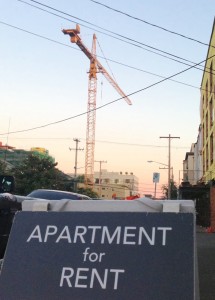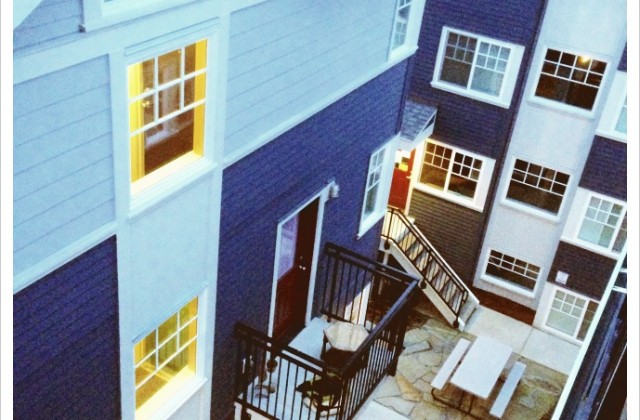Mayor Bites Dog: New Storyline on Microhousing
Here’s the headline from KIRO:
Ballard residents ambush Seattle mayor over development
At first, you might think that this headline is “bad news,” especially since it is about a microhousing project in Ballard.
But think about this for a moment. Change isn’t easy. When change comes, the people with the most invested in the status quo have the most to lose. Usually, the press presents a story about how developers are pushing change for their own benefit. The story, the interest, is all about how developers are changing things.
Somehow, we’ve changed the storyline
Now, angry neighbors are finally being called out for their behavior. A celebratory event was “ambushed” by neighbors worried about change. Instead of a headline that reads, “Micorhousing Arouses Concern Among Neighbors,” the headline calls attention to the neighborhoods behavior.
Not only that, but here’s how the Mayor responded:
What we’ve seen is the rise of these micro apartments because it’s affordable living for people who don’t want to own a car and want to use transit and ride a bike,” said McGinn. “And they’ve been very popular. And it’s an affordable way for a young person or an older person to live in the neighborhood where they work.
Even in an ambush, the Mayor acknowledged how important microhousing is to the mix of housing Seattle needs if it is going to grow sustainably.
Today at noon, the Mayor and Senator Ed Murray will be at the meeting of the Ballard Chamber of Commerce to discuss a variety of issues. If you care and you can, go there to express your views about microhousing.
Until the Cows Come Home: Soaring Rents Should Mean More Housing
The Seattle Times headlined its Sunday edition with a story about “soaring rents” in Seattle. If we, as a city, decide that rents are too high, there is a solution: build more housing. But the article entertains the bizarre notion—all too commonly held by policy makers and others—that somehow building more housing increases price. Here’s a quote from the story:
What’s fueling rent increases most is development itself, said Jonathan Grant, the Tenant Union’s executive director. If almost all new units cater to wealthier tenants, he said, increasing supply is no path to getting rents to go down or even level off.
“The reality is that these units are high-cost, and often these were taken out of affordable-housing stock,” Grant said. “That’s why you see this theory of supply and demand being turned on its head.”
Grant’s suggestion is that the reason why rental housing prices are going up is because we’re building too much of it and for the wrong people. But as I have written before, developers don’t set rents, the market does.
Builders don’t buy land, build apartment buildings, then step back on the sidewalk in front of the building rubbing their hands together gleefully at the thought of charging people $2,000 a month for each unit.
Rents are established based on recovering costs for materials, money (in the form of short or long term debt), and operations. Profit, if there is any, comes after all those costs are paid with rent revenues.
Banks and investors simply won’t allow a project to be built with rents that exceed what they believe people can and will pay. They won’t do it. We can dispense with the idea that builders are building for wealthy people, which attracts more wealthy people, which in turn increases prices. Prices go up based on costs and competition. If we want prices lower, then we should want competition between developers, not among renters bidding against each other for a dwindling supply of housing.
If we’re going to make life more affordable in Seattle we need to shift our attention to supply. The burden shouldn’t be on housing advocates to explain why building more housing would help stabilize housing prices, but on NIMBYs and regulators to show how adding costs and process to new development won’t raise the prices.
Housing is probably the only product essential for people to live that has caps and limits on its production. Imagine if the farmers that produce food could only produce a set amount of their products. What would happen to the price of milk, for example, if dairy farmers could only produce 1 million gallons of milk per year, regardless of how many people wanted to buy milk?
Add to this production limit on milk, design review for the cows the famer uses to make milk. Imagine a public process that allowed members of the public worried that there is too much milk to prescribe the size and color of the farmer’s cows. And imagine that the farmer pays for that public process out of her budget. If we regulated the production of milk that way, prices would “soar” just like rents have in Seattle.
Cities are always going to feel more expensive and usually are. But to affect price we should be create more and better housing, even incentivizing the building of that new housing by reducing rules, risks and costs.
What Seattle needs is a housing policy that provides generous financial help for people who truly struggle to find shelter in the city and fewer regulations—for both market rate and non-profit developers—so that all people can have a wide array of housing options and prices to choose from in the city.
Photo of Design Review Cows from MorgueFile
The Case for Increasing Housing Supply, Choice, and Diversity
Last week I posted at the Seattle Transit Blog about a report that’s gotten a lot of attention in the media. The researchers analyzed lots of economic data and found that when people with different levels of incomes live more closely together, those with lower incomes tend to do better in the long run; in other words, when people who earn less money live closer to those with higher incomes, their incomes tend to go up.
What difference does this make for small-lot development and microhousing? The study seems to indicate that all levels of income are better off when they live closer together. Housing type tends to indicate income, with higher earning families tending to favor single family homes while those with lower incomes tend to be renters.
Broadly speaking this means upwardly mobile people living in single family homes and lower income singles living in microhousing is a good combination for overall upward mobility in Seattle. Put higher earners together with people who earn less and those that earn less do better over time. If Seattle can get its housing and land use policies right, we can support all kinds of housing types in Seattle, making our city a place where everyone can afford to live.
Now, the study is very clear that these are correlations and that we can’t know for sure that pushing more people of different incomes together in a city will for sure result in economic benefits for everyone. But it confirms what we already know, that sprawl costs more for poor people and that creating more housing choices for all levels of income is better for the environment and people’s bank accounts. And if we want to stop sprawl, we’ll need lots more housing of all types in Seattle for people of all income levels. This is something some of us have been saying for more than two years. Others are now starting to come along: we need more housing supply, choice, and diversity.
Here’s an example of comments from a reader, Charles B, at STB on my post:
Charles B says:
The only thing that will really bring down rents is to remove restrictions that prevent new housing units from being built, whether that be height limits or neighborhood backlash against new development.
and
Charles B says:
If $600/mo one room apartments are possible in a place as densely populated and pricey as Tokyo, surely they are possible here. Its merely an issue of supply and demand.
Single family homes are great for individuals, but we are passing the point as a city where one of those is affordable to someone who is not commanding a very generous salary. Unless we want to doom all of our working and middle class residents (including quite a number of us on this blog no doubt) to ever longer commutes on ever crowded freeways, we are going to have to give up more single family homes and protected 180 degree views for the wealthy.
On the plus side, bringing people back into the city of all income levels will bring more opportunity for a more vibrant street life, with bigger block parties, bigger festivals to attend and a much more diverse restaurant and shopping scene.
I would much rather live in a city like that than someplace that is trying very hard to become the next Palo Alto
I think Charles B is wrong about single-family housing; people still want it. We’re better off building single-family housing here, in Seattle, rather than forcing those people to find those homes in Issaquah, Bellevue, or Maple Valley. And we can make that happen, if we just get good policy like the 80 Percent Rule passed so we can build predictably and at an appropriate scale in existing single-family neighborhoods. The point is that if we truly want life to be more affordable in Seattle we need more new homes, of all kinds, here in Seattle, not at the end of a long, expensive freeway commute.
DPD Recommendations on Microhousing: Why Subject a Good Thing to a Bad Process?
What follows is the text of a letter sent by Smart Growth Seattle last week in response to the Department of Planning and Development’s recommendations to the City Council on microhousing.
The Planning, Land Use, and Sustainability Committee will soon be considering legislation that would affect future microhousing developments; that legislation is likely to be based, in part, on recommendations by the Department of Planning and Development (DPD). Smart Growth Seattle intends to stay actively engaged in the legislative process in the coming months.
The evidence is overwhelming: microhousing safely and efficiently meets a critical housing need in the city. Furthermore, microhousing is a healthy and affordable housing choice for the many people of all ages who want to live in the city and prefer less space. We need to keep this housing choice available and affordable.
However, the recommendations forwarded to you by DPD—especially the suggestion to require design review—will not substantively address the worries of neighbors and will simply add additional cost to projects which will lead to higher rents, harming the biggest benefit of microhousing—its affordable price. Why subject a good thing–microhousing–to a bad process?
What follow is our detailed responses to DPD’s recommendations. The DPD recommendations are in bold followed by our response.
Define “Micro Dwelling Unit” as a subset of “Dwelling Unit” in the Land Use Code
Smart Growth Seattle supports the definition proposed by DPD with the exception of requiring a maximum size for micro dwelling unit. If the concern is that larger size will encourage more than one resident, the 8 person limit would prevent that.
If the concern is that some developers might be trying to create smaller apartments without full kitchens, we don’t see any reason to limit this if owners can fill units that are larger than 285 square feet and otherwise fit the micro dwelling unit definition proposed. Customers in search of housing should have every choice open to them and builders should be able to be innovative in responding to their choices.
Design Review. Apply Threshold for Micro Dwelling Units and Congregate Residences by Building Size
We appreciate DPD developing a threshold for design review that is based on building size not number of units. Building size is what is visible to the neighborhood, not individual units, and the size threshold is consistent with principle behind SEPA thresholds.
However, there is almost universal sentiment—not just among developers but residents, as well—that the current system of design review—including so-called Streamline Design Review—is broken. The process is open-ended, too costly, and has no impact on the concerns surfaced by neighbors. Design review has no effect on parking, for example.
Even City staff made the observation that after going through the design review process “projects showed little evidence of substantial modification” (see page 3 of the recent report written by DPD at http://clerk.seattle.gov/~public/meetingrecords/2013/plus20130628_4b.pdf).
We believe that before microhousing projects are subjected to this expensive, time consuming, and ineffective process it should be fixed so that design review becomes a useful, predictable, and more affordable process for all projects in the city. And if notice is an important issue to microhousing opponents, we think a mailed notification to residents within 800 feet of a project during permitting would make more sense than requiring design review.
SEPA Thresholds and Growth Targets
We agree with the DPDs proposals on SEPA thresholds for microhousing. We are concerned, however, that in areas that have reached their growth targets, microhousing and all other housing would be exposed to the costs and uncertainties of SEPA review. As we pointed out in our last memo, growth targets should be floors not ceilings for growth.
Prohibit new Micro Dwelling Unit development in single-family zones
We see this as a potential loss of housing supply and choice in Seattle’s single-family neighborhoods. Our view is that if there is demand for microhousing in single-family neighborhoods, it should be allowed.
Adjust refuse collection areas in Micro Dwelling Units and Congregate Residence developments
As we pointed out in our last memo, garbage is an issue in every neighborhood and for every housing type. Educating people and managing how they dispose of their garbage is an ongoing issue in cities of all sizes. However, we feel this proposal is a reasonable one and would allow an evolving solution based on interaction between staff at Seattle Public Utilities, developers, building managers, and customers.
Size minimums for Micro Dwelling Units and Congregate Residences
We agree with DPD that the existing building code and the housing market should set the size of Micro Dwelling Units. Imposing a size requirement is forcing microhousing customers to buy more housing than they want to buy, driving up their monthly housing costs. Customers and developers should be allowed to set the size based on the existing limits, costs, and what customers are able to pay for housing.
Restricted Parking Zone (RPZ): Clarify regulations or rules for Micro Dwelling Units and Congregate Residences
As we have pointed out (and has been reported in the media), microhousing is actually a parking solution, since most residents of microhousing don’t drive and microhousing buildings, because they have fewer qualifying units, actually use fewer RPZ permits. We welcome a closer look at how microhousing supports fewer cars and fewer parking problems in neighborhoods.
We look forward to working with you and DPD staff as you deliberate next steps on microhousing. In the end, we think Council ought to consider how to make building microhousing easier so that it can continue to be choice for people shopping for affordable housing. More process and costs will not help make microhousing more available to the many people who want to live in these homes.
Seattle Times: Fewer Rules, More Housing
 Affordability is a relationship to price, a relationship that is conditioned by a person’s income and expenses. This dependence on income and expenses is just as true for food as it is for housing and other of life’s essentials; the less money we earn, the more money we spend, the more expensive and less affordable life becomes.
Affordability is a relationship to price, a relationship that is conditioned by a person’s income and expenses. This dependence on income and expenses is just as true for food as it is for housing and other of life’s essentials; the less money we earn, the more money we spend, the more expensive and less affordable life becomes.
A recent Seattle Times editorial shows a promising change in the language being used to talk about housing affordability in Seattle. The editorial links housing supply and the costs associated with building housing with higher prices. Basic economics for housing or any other product dictates that increases in supply when demand is constant can result in lower prices. Higher production costs don’t help with price either. So the Times Editorial board is starting to get it:
The City Council can streamline the permitting process and change zoning laws to create incentives for developers.
And
Construction of affordable housing has not kept up with demand. Rent surged by 3 percent citywide within the past three months alone, while vacancy rates dropped to 4.41 percent from 4.83 percent a year ago, according to Apartment Insights. The average rent increased from $1,155 to $1,190 per unit. In the Capitol Hill neighborhood, rents soared 8.2 percent to $1,395 each month.
These things are true. If the Council made a serious effort to relax requirements on new housing construction (and create real incentives for building housing not taxes on new housing) we’d get more housing, enough to keep up with growing demand created by an economy that is creating more jobs and more growth in our city.
This, if combined with more financial help for people at the lowest levels of income in our city, would begin to substantively affect housing price and people’s relationship to price, opening more opportunities for people to live and work in Seattle. But how do we get there?
The first and most important step is to aggressively but wisely deregulate the housing market in areas of our city that can most effectively absorb new growth with transportation infrastructure; that means more growth in areas already zoned for density with easy transit access.
A review of the costs of affordable housing developments in Washington found that
affordable housing projects are sometimes subject to additional requirements at the local level that add to their development cost. Local jurisdictions may require a project to include certain elements, such as structured parking, or to contribute to development of off-site infrastructure, such as water and sewer line extensions, street improvements, sidewalks, and street lights.
There are too many rules that add to the time and cost of building housing whether the project is built by for profit or non-profit housing developer.
Second, if innovation is encouraged new housing solutions like microhousing and small-lot development can meet the need for what has often been called “workforce housing;” that is housing that is priced affordably for people who earn around 60 to 80 percent of Area Median Income (AMI), about $50,000 per year or $1,200 per month for housing.
Microhousing easily meets this demand in the housing market, producing units that are priced, often, well below the high end of the workforce housing AMI. Many of the residents of microhousing earn significantly less than 60 percent of AMI, but choose to live in microhousing because while they might be spending more than 30 percent of their monthly income of rent, their other costs for things like transportation are far lower.
If developers are allowed to innovate, producing lots more housing, market prices will fall; they might even fall enough to meet the needs of people who earn 60 percent of AMI or less, levels of income that potentially qualify for housing assistance. Thinks about that for a moment: if the market produces housing affordable for people at 50 percent of AMI, that would mean precious public dollars could be concentrated on people who earn 40 or 30 percent of AMI.
Some levels of income will always require a subsidy for housing, but lowering overall housing prices, decreasing transportation costs, increasing wages, lowering health care costs can all contribute to making the city more affordable. This is particularly true for the group the Times describes as being the most in need, “someone who earns the minimum wage of $9.04 per hour and can afford only $470 per month on rent.”
The way we make life easier for the hardest working but lowest paid people in our economy is to let housing supply and choice grow while maintaining healthy housing assistance programs. If we combine increases in wages, lowered costs of living, and lower housing price through increases in supply the goal of a “rich socioeconomic, ethnic and cultural diversity” is truly achievable in Seattle.





